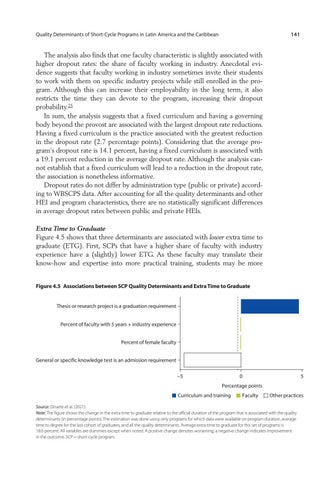141
Quality Determinants of Short-Cycle Programs in Latin America and the Caribbean
The analysis also finds that one faculty characteristic is slightly associated with higher dropout rates: the share of faculty working in industry. Anecdotal evidence suggests that faculty working in industry sometimes invite their students to work with them on specific industry projects while still enrolled in the program. Although this can increase their employability in the long term, it also restricts the time they can devote to the program, increasing their dropout probability.25 In sum, the analysis suggests that a fixed curriculum and having a governing body beyond the provost are associated with the largest dropout rate reductions. Having a fixed curriculum is the practice associated with the greatest reduction in the dropout rate (2.7 percentage points). Considering that the average program’s dropout rate is 14.1 percent, having a fixed curriculum is associated with a 19.1 percent reduction in the average dropout rate. Although the analysis cannot establish that a fixed curriculum will lead to a reduction in the dropout rate, the association is nonetheless informative. Dropout rates do not differ by administration type (public or private) according to WBSCPS data. After accounting for all the quality determinants and other HEI and program characteristics, there are no statistically significant differences in average dropout rates between public and private HEIs. Extra Time to Graduate Figure 4.5 shows that three determinants are associated with lower extra time to graduate (ETG). First, SCPs that have a higher share of faculty with industry experience have a (slightly) lower ETG. As these faculty may translate their know-how and expertise into more practical training, students may be more Figure 4.5 Associations between SCP Quality Determinants and Extra Time to Graduate Thesis or research project is a graduation requirement Percent of faculty with 5 years + industry experience Percent of female faculty General or specific knowledge test is an admission requirement −5
0
5
Percentage points Curriculum and training
Faculty
Other practices
Source: Dinarte et al. (2021). Note: The figure shows the change in the extra time to graduate relative to the official duration of the program that is associated with the quality determinants (in percentage points). The estimation was done using only programs for which data were available on program duration, average time to degree for the last cohort of graduates, and all the quality determinants. Average extra time to graduate for this set of programs is 18.6 percent. All variables are dummies except when noted. A positive change denotes worsening; a negative change indicates improvement in the outcome. SCP = short-cycle program.

